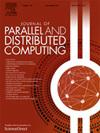Distributed robust multitask clustering in wireless sensor networks using Multi-Factorial Evolutionary Algorithm
IF 3.4
3区 计算机科学
Q1 COMPUTER SCIENCE, THEORY & METHODS
引用次数: 0
Abstract
When data collected at the local nodes of a wireless sensor network (WSN) are volumetric in nature, there is a need for local processing, then distributed clustering plays an important role. Traditional clustering algorithms based on K-means, K-medoid are not effective in these scenarios for accurate data segregation. Further, there is a requirement of techniques that can effectively handle outliers and noise present in the sensed data. Thus, there is a need to design robust distributed data clustering algorithms. Multi-Task Optimization (MTO) has taken the attention of researchers in the last couple of years after the introduction of Multi-Factorial Evolutionary Algorithm (MFEA). The MFEA can handle several single objective tasks usually related to one another and share implicit knowledge or abilities common to them. In this manuscript, the MFEA is employed to solve two tasks: 1) outlier detection and 2) perform distributed clustering at the nodes of WSN. The resultant algorithm, termed as Distributed MFEA (DMFEA), effectively removes noise and segregates data present at multiple nodes of WSN. Simulation study reveals the superior performance of DMFEA over benchmark algorithms like distributed versions of K-means, particle swarm optimization, and moth-flame optimization on two synthetic and six real-life datasets based on forest fire monitoring, air pollution indexing, Intel laboratory environment sensing, agriculture soil quality labeling, river water quality analysis, and land mine detection. The superior performance of DMFEA is demonstrated based on the Silhouette Index of obtained clusters and the percentage of outliers detected. Additionally, the DMFEA average rank in Kruskal Wallis test, is better over the three comparative algorithms.
基于多因子进化算法的无线传感器网络分布式鲁棒多任务聚类
当无线传感器网络(WSN)的局部节点采集到的数据是体积数据时,需要进行局部处理,这时分布式聚类就发挥了重要作用。传统的基于K-means、k - medidoid的聚类算法在这些场景下无法实现准确的数据分离。此外,还需要能够有效处理感测数据中存在的异常值和噪声的技术。因此,有必要设计健壮的分布式数据聚类算法。随着多因子进化算法(MFEA)的提出,多任务优化(MTO)问题近年来引起了研究人员的广泛关注。MFEA可以处理几个通常相互关联的单一目标任务,并共享它们共同的隐性知识或能力。在本文中,使用MFEA来解决两个任务:1)异常点检测和2)在WSN节点上进行分布式聚类。所得到的算法被称为分布式MFEA (DMFEA),它可以有效地去除噪声并分离存在于WSN多个节点上的数据。仿真研究表明,DMFEA在基于森林火灾监测、空气污染索引、英特尔实验室环境感知、农业土壤质量标记、河流水质分析和地雷探测的2个合成数据集和6个真实数据集上,优于分布式K-means、粒子群优化和蛾焰优化等基准算法。基于获得的聚类剪影指数和检测到的异常值百分比,证明了DMFEA的优越性能。此外,DMFEA在Kruskal Wallis检验中的平均排名优于三种比较算法。
本文章由计算机程序翻译,如有差异,请以英文原文为准。
求助全文
约1分钟内获得全文
求助全文
来源期刊

Journal of Parallel and Distributed Computing
工程技术-计算机:理论方法
CiteScore
10.30
自引率
2.60%
发文量
172
审稿时长
12 months
期刊介绍:
This international journal is directed to researchers, engineers, educators, managers, programmers, and users of computers who have particular interests in parallel processing and/or distributed computing.
The Journal of Parallel and Distributed Computing publishes original research papers and timely review articles on the theory, design, evaluation, and use of parallel and/or distributed computing systems. The journal also features special issues on these topics; again covering the full range from the design to the use of our targeted systems.
 求助内容:
求助内容: 应助结果提醒方式:
应助结果提醒方式:


